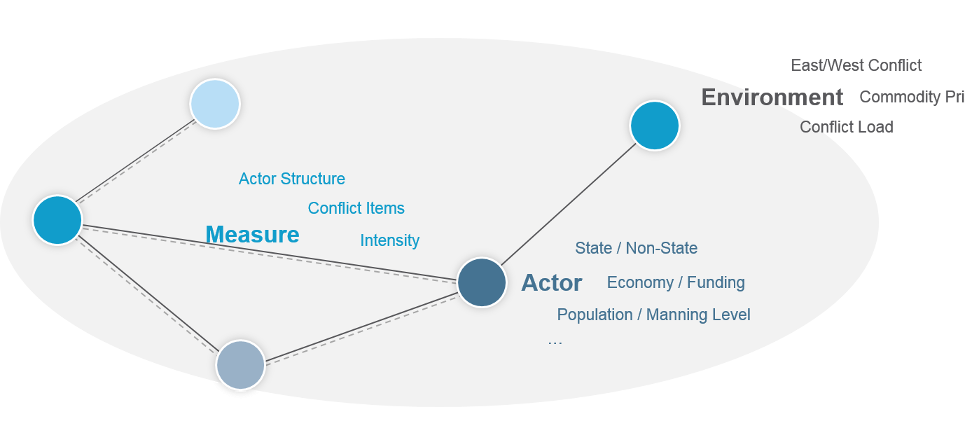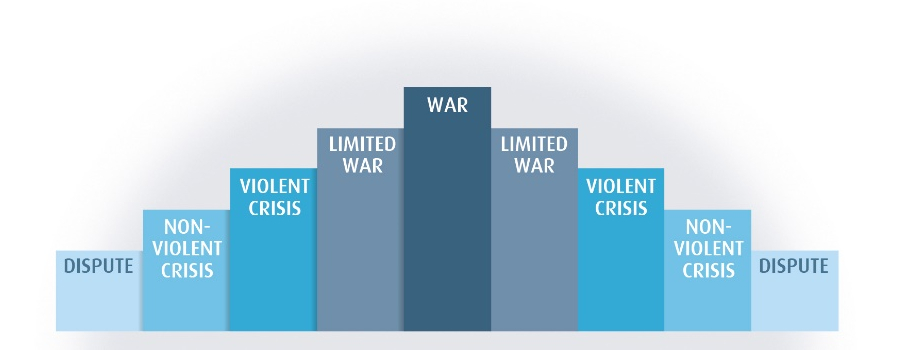Conflicts as social systems
The CONIAS approach conceives conflicts as social communications. These communications can manifest from announcements, threats, sanctions, but also from combat operations with light or heavy weaponry, bomb explosions or targeted assassinations. Also negotiations, arbitrations, mediations, peace agreements and other treaties are counted as part of the conflict communication. All in all the CONIAS catalog differentiates between 200 measures in four groups and twelve categories.
Each communication has its author and its addressee. This could be a state, a non-state actor, a private organization or in special cases even a particular person. The actors can be differentiated according to their role within a conflict; direct actors, those who want the conflict item for themselves and communicate it, supporters, who support one or multiple directly involved actors with financial, military or political aid and lastly arbitrators and mediators. The latter do not have an interest in the conflict item, but want to end the violence or find a solution to the conflict (for more detail see Schwank 2012).

Dynamic mapping in time and space
The contemporary analysis of political country risks does not only require a detailed description of the current threats, but also seeks answers to the questions when and where risks occur. The CONIAS approach solves this problem by accurately capturing the communication between the actors in its geographic and temporal dimensions and evaluating its intensity. A further novel development by CONIAS Risk Intelligence is that the geographic space of actions can be mapped in detail due to the usage of precise geo-referential data. As a result, the risk, which arises from political conflicts, can be measured and calculated more accurately than before.
Definition of a political conflict
Political conflicts are part of the everyday political life – especially in democracies. CONIAS however, wants to capture only those conflicts that have the potential to become a threat or do in fact lead to a reduction of the physical security. The following criteria within a social system have to be fulfilled to count as a political conflict according to the CONIAS approach:
-
Dissent in a political topic: At the beginning of every political confrontation is a dissent: one of the involved parties is unsatisfied with an existing or upcoming regulation and communicates this. It is crucial that this ‘no’ is connected with a politically relevant issue that is a societally relevant topic. The CONIAS approach specifies ten possible conflict items, including a residual category.
-
Assertiveness of the actors: The above-mentioned political conflicts only count as relevant for CONIAS, if the involved actors are assertive or appear as such. Assertive actors, or those who appear that way, are actors who are able to damage the opponent in a manner so that they have to react.
-
Conduct at the fringes or outside established regulatory procedures: Many political conflicts between assertive actors are standardized. For example through parliaments, judicial institutions or other established regulatory procedures, such as wage disputes. For CONIAS however, only those political conflicts matter, which are either conducted outside established procedures or are likely to transgress them.
Assessment of the intensity for a specific space of time

CONIAS distinguishes five conflict levels in total that a conflict can reach
-
Dispute: the social system in question fulfills the basic definition of a political conflict. That means that a conflict of interest about a societally relevant conflict item between assertive actors is present. The conflict is conducted outside or at the fringes of established regulatory procedures.
-
Non-violent crisis: the most important signifier here is that the conflict is conducted without violence, but at least one actor presented the prospect of using violence (for example with the deployment of troops or maneuvers close to a border), threatened to use force or calls for it.
-
Violent crisis: this conflict level is virtually a transition between nonviolence and war. Within this conflict phase mostly singular actions are observable such as riots during demonstrations, bombings, targeted assassinations or actions alike that aim at inciting fear and terror. Moreover, skirmishes at the border or raids on villages are typical for this level. All in all however, the extent of the combat operations and the magnitude of the destruction stay on a low level.
-
Limited war: Within the level of limited war, systematic and extensive combat operations already occur. However, the violent conflict events mostly locate within a single or few regions. The extent of the combat operations and the magnitude of the destruction reach a medium to high level.
-
War: War signifies an involvement of the entire society of a region or country in the hostilities. Physical security is no longer present. The extent of the combat operations as well as the magnitude of the destruction are on a high or very high level.
To evaluate the extent of violence, the following indicators are used:
- Scope of the deployed personnel
- Type and application of the weaponry
- Number of casualties
- Number of refugees
- Extent of the damages to the infrastructure
Temporal and spatial capture of the conflict intensity
-
Up till 2010, the captured intensity of the continuous data collection relates to the entire state territory, where a conflict was conducted. The duration or phases of intensity was related to the first and last day where the most violent measure was adopted.
-
As of 2011, the intensities are mapped for each first tier administrative division of the respective country and on a monthly basis.
Geo-referenced localization of the conflict output
CONIAS Risk Intelligence uses the first subnational administrative unit of states as the foundation for the localization of the intensity of political conflicts. That way, nuanced situation maps of conflicts can be issued, the dynamics of conflicts can be captured and secure areas can be determined.

The second tier for the assessment of the geographic dimension of the political conflict output is the individual measure of the conflict output. The location information is precisely captured, connected with the exact date and type of measure and jointly evaluated.

The contested commodities within a conflict
Despite being the goal of many qualitative studies in the area of conflict research, the determination of the factual causes of conflicts are difficult to identify, due to the long history and complexity of political conflicts. Undoubtedly possible however, is the determination of the contested commodities within a conflict: what is the conflict item?
The CONIAS approach distinguishes between ten distinct conflict items. A conflict can address multiples of these items. For the duration of a conflict, the number and type of conflict items can change.
- Ideology / System
- Secession
- International Power
- Territory
- National Power
- Resources
- Autonomy
- Decolonialization
- Regional Predominance
- Others
Distinction between different conflicts within a state / region
The CONIAS approach aims at the identification, analysis and ultimately also the prognosis of conflict dynamics. The analysis level ‘war of state disintegration in EX-Yugoslavia’ for example, does provide for an overview, but inhibits a detailed insight into the different developments of the region.
In order to demarcate conflicts from one another three constituent elements of; a political conflict, the addressed topic, the actors and the adopted measures are used. Only if these elements are congruent, one can consider it as the same political conflict.


